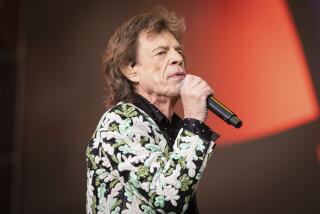Rock Hall snub irks ex-Monkee
- Share via
“So you better get ready,” shouts the theme to the Monkees’ 1960s TV series, “we may be comin’ to your town!” Unless, of course, your town is Cleveland.
Peter Tork says the Monkees merit consideration for the Rock and Roll Hall of Fame, but one man opposes their induction.
“The only person ... holding a grudge is Jann Wenner of Rolling Stone,” says the former Monkee. The magazine editor “has never written a gracious word. He personally has the veto power to keep us out.”
How do the Monkees -- whose Emmy-winning show aped the Beatles’ film “A Hard Day’s Night” -- rank against other inductees? With 10 top 20 singles, they have more than the Animals, the Rascals, the Lovin’ Spoonful, the Dells, Del Shannon, Frankie Lymon and Black Sabbath.
Bands as disparate as the Sex Pistols (“Steppin’ Stone”), Run-DMC (“Mary, Mary”) and the Church (“Porpoise Song”) have covered Monkees’ songs. Even Radiohead’s “Go to Sleep” eerily channels Micky Dolenz’s vocals.
“I’m convinced that Micky is one of the great singers of our time,” Tork says. “He’s always been something of a genius.”
One notable fan is Michael Stipe, who reportedly vowed to bar R.E.M. from the Hall until the Monkees got in. Stipe declined comment, but in 1994 he did tell Rolling Stone that “the Monkees ... meant a lot more to me” than the Beatles.
R.E.M. was finally inducted this year.
Wenner -- who didn’t reply to an interview request -- allegedly denounces Tork, Dolenz, Davy Jones and Mike Nesmith for not playing their own instruments on the band’s first albums.
In this “American Idol” era, when acts are “manufactured” like toasters, fewer critics crucify the Monkees for being a TV show that spawned a band. So have they faced an unfair standard? Were they, in fact, a “real” group?
“I’ve not heard the slightest murmur about the Monkees being fake,” Tork, 65, says from his Connecticut home. “Everybody’s forgotten it, except Wenner. He’s been vicious.”
Backed by producer Don Kirshner’s songwriting stable -- Carole King, Gerry Goffin, Neil Diamond, Neil Sedaka, Tommy Boyce and Bobby Hart -- the band unleashed four straight No. 1 albums and three chart-topping singles. They eventually penned their own catchy pop tunes, albeit with less chart success.
“George Harrison used to say he wished his best songs were as good as the worst of Lennon-McCartney,” Tork says. “So, we used to hope our best songs were as good as the worst of the Brill Building.”
Tork’s fame, however, is more about musicianship than songwriting. So said Jimi Hendrix, who called him the most talented Monkee. The guitarist opened several Monkees’ gigs, including a ’67 show at New York’s West Side Tennis Club. Was his compliment accurate?
“I’m not sure it’s quite true,” says Tork, who plays guitar, banjo, piano and bass. “I’m far and away the best-trained musician, but I’m in awe of all three [Monkees]. Jimi meant that I was the most [receptive] to his kind of music.”
Tork’s new album -- Shoe Suede Blues’ “Cambria Hotel” (sold at www.cdbaby.com) -- features guitarist Richard Mikuls, bassist Arnold Jacks and drummer Jeff Olson. The band’s name doesn’t reflect Elvis so much as a less fractious era in radio.
Besides a bluesy “Last Train to Clarksville,” its hidden gem is an Indian violin-laced “For Pete’s Sake,” a.k.a. the show’s closing theme. The album has medicinal value, Tork suggests.
“People listen to dance music like taking aspirin: to shut down the pain,” he says. “But the blues puts you back together. Like penicillin, it’s therapeutic. If I can bring a microscopic bit of that feeling ... my career’s in good shape.”
More to Read
The biggest entertainment stories
Get our big stories about Hollywood, film, television, music, arts, culture and more right in your inbox as soon as they publish.
You may occasionally receive promotional content from the Los Angeles Times.







